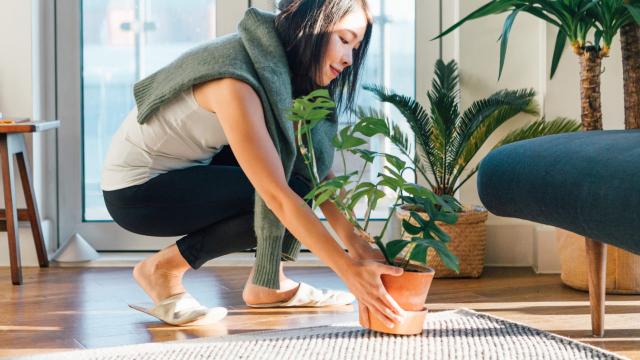If you’ve been reading along lately, you’ll know that we’ve been doing some research into the art of keeping your darling house plants alive. Doing our very best Planthacker work, if you will.
Last time, we looked into how to avoid drowning your plant babies with too much water (been there, honey) and today, we’re taking a peek at sunlight. That unpredictable beast.
Here’s what I’ve discovered:
Generally-speaking, well-lit rooms are best for house plants:
In an update shared by We the Wild, they advised that in most cases, house plants are going to enjoy “bright indirect sunlight”.
“If you can easily read a book without the light on, the room is perfect for houseplants,” they wrote.
“There are many exceptions to the rule, and it’s best to chat to your local independent nursery or plant store for advice.”
The in-house horticulturalist from The Jungle Collective explained to me over email that:
“Most plant varieties especially tropicals will thrive in bright indirect light this means the room is brightly lit but no direct sunlight is on the leaves. Cactus and succulents need very bright light/full sun so when keeping them indoors they will thrive on a window ledge or as close as possible to the window. “
Okay, that’s great, but what are the exceptions?
There are some indoor plants that really dig low-light environments (like vampires). Lucky for you, pop up plant nursery The Jungle Collective has put together a list of those very plants.
First up, low light definitely does not mean “no” light. After all sunlight is food for your plants. If they don’t get any at all, their health will look pretty miserable. The Jungle Collective’s website reads:
“Plants need light to photosynthesize. If there’s no light plants will slowly die. If a space has no natural light some artificial lighting can be used such as UV lights or grow lights.”
So if you have a dim room, your best bet is going to be something like a Zanzibar Gem, Snake Plant, Peace Lilies, Pothos plants or a Rubber Tree (loads more here).
How to tell if your plant is getting too much or too little light:
According to a piece by the ABC, frequent yellowing of leaves can be a sign of too much sun. If you’re noticing your baby’s leaves are turning golden like, all the time – something is up. Try moving it to a different spot.
Brown or burnt-looking spots are more signs that your plant may be getting a little too much light. These spots are literally sunburns. Get them out of that direct light, quicksmart!
On the flip side of this, the ABC wrote that plants that are growing all spindly may be searching for more light, so help them out by giving them a little more access.
Symptoms like little growth and “leaves dropping off starting at the bottom of the plant” are also signs your plant needs more light, the Jungle Collective shared.
And if you need more light?
The Jungle Collective explained to me that there are options for artificial light that work well, also.
“Grow Lights are an amazing solution for little or no light. Most plants can grow well in 100% artificial light. Look for a full spectrum led which is perfect for all growth stages. When using artificial light, you will need continuous light for 12 hours per day. Plants do require a night phase so give the plants a 12-hour break from the lights at night. Most grow lights come with a timer so you can set and forget.”

Leave a Reply
You must be logged in to post a comment.